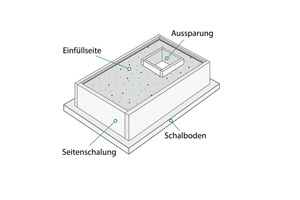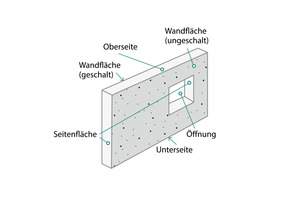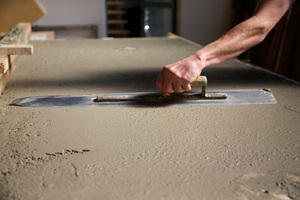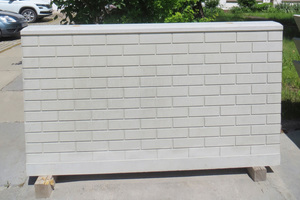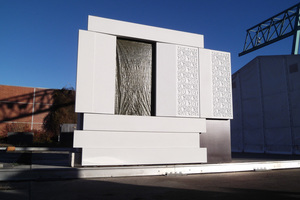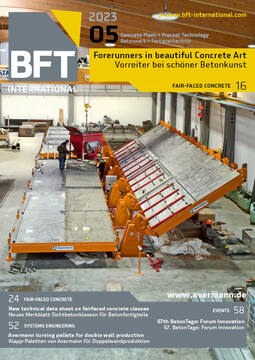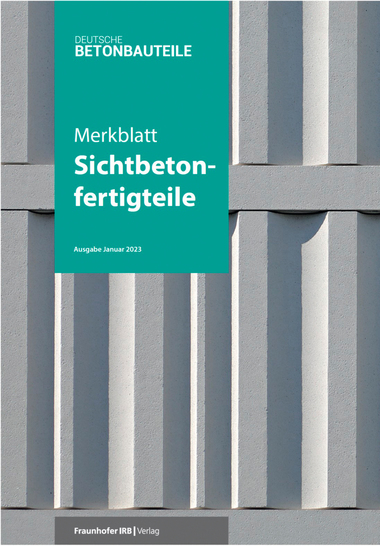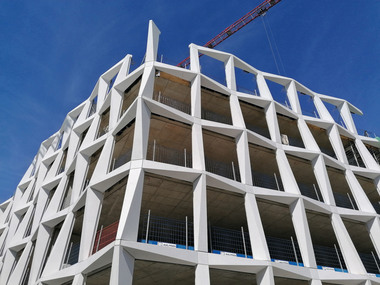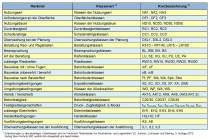New technical data sheet “Merkblatt” on fair-faced concrete classes for precast elements
The new technical data sheet on fair-faced concrete [1] extends the concept of fair-faced concrete classes [2] established for in-situ concrete construction by adding specific requirements for precast construction. It addresses builders, architects, precasters and building contractors with important recommendations for planning and execution.
Concrete is one of the most versatile and diverse construction materials of our time. It serves as structural building material and is comprehensively standardized and regulated for this task. But concrete also frequently serves for the design of buildings. Fair-faced concrete is referred to when requirements for the appearance of concrete surfaces are defined as early as in the planning stage and will later be permanently visible on the building.
The requirements for fair-faced concrete are therefore characterized by expectations that are placed on its visual appearance and that are accordingly part of the architectural design. The design possibilities here are virtually unlimited. Not only the composition of the concrete, but also the type of form fabric used and subsequent processing of the surface can achieve quite varied visual and haptic impressions. Specifications on fair-faced concrete therefore require a very precise and individual description and close coordination between planning and execution. The more execution varies from normal standards, the greater the expected costs.
Practice has shown that, for the majority of implemented fair-faced concrete buildings, the entire bandwidth of design possibilities is not drawn upon. The expectation is, accordingly, “beautiful concrete.” Because concrete consists primarily of natural constituents that are subject to unavoidable natural fluctuations, and that are partly processed manually, every concrete surface is unique. In the same way, the idea of what “beautiful concrete” actually represents can vary greatly from individual to individual.
The classification system for fair-faced concrete, with classes SB 1 to SB 4, has nevertheless become established over the past two decades for describing fair-faced concrete surfaces in concrete construction. This system was introduced in the first version of the DBV/VDZ Merkblatt on fair-faced concrete [2]. Here, the focus is on creating an overall impression as uniform as possible of fair-faced concrete surfaces, divided into four quality levels. A fair-faced concrete surface can be allocated to a fair-faced concrete class, depending on the visual significance of the fair-faced concrete surface, on the observational distance from the fair-faced concrete surface in a building in common use as well as on how much time and effort – also in terms of cost – are invested to achieve the specified result. Fair-faced concrete classes are based on a contractual agreement between client and contractor and on an established description of the fair-faced concrete surface as worked out by experts and as proven in practice. These take into consideration, in a balanced manner, both the various quality expectations of the client as well as the technically feasible fair-faced concrete surfaces – with account likewise taken of the usual time and expense required by the contractor for executing the work to achieve the respective fair-faced concrete class.
The classification system described in the current DBV/VDZ Merkblatt on fair-faced concrete [2] is also often applied in precast construction. However, since their requirements have been derived from in-situ concrete, topics specific to precast elements (e.g., production-specific aspects of great significance involving unformed surfaces and influences arising from transport, as well as intermediate storage of precast elements), are not or are not fully taken into consideration. In practice, this leads again and again to deficiencies in planning and in preparation of tender documents for precast fair-faced concrete elements. As a consequence, realization of the desired fair-faced concrete quality is not achieved, or confusion arises as to how to handle the precast-specific influences that are not considered in the existing classes of the DBV/VDZ-Merkblatt on fair-faced concrete [2]. Here is where the new Merkblatt on precast fair-faced concrete elements [1] comes into play, by picking up on the existing systematization of the fair-faced concrete classes from DBV/VDZ-Merkblatt on fair-faced concrete elements [2] and by supplementing it by considering precast-specific aspects. In addition to an extension of classification systematization, including a description of unformed surfaces, the new Merkblatt on precast fair-faced concrete elements [1] also provides important recommendations on the features that require special consideration in planning fair-faced concrete surfaces when building with precast elements.
Recommendations and requirements
The requirements placed on precast elements include such criteria as configuration of the in-fill side, storage and transport, structuring of the surfaces with joints and with the size of the element, surface processing and possible experimental elements of real size.
The great advantage in production of precast elements is that they do not need to be cast in the same orientation as they are subsequently installed in the building. This prevents, for example, excessive casting heights and flaws in casting and compaction. For this reason, precast elements are primarily produced in a horizontal position (Fig. 1): i.e., the concrete is cast into the formwork from one side so that this side is later executed as unformed surface. Such surfaces can be fair-faced concrete surfaces (Table 1). It should be kept in mind here that optical production-related differences occur between the cast and the unformed surfaces. It is for the planner to decide how the surface is processed and accordingly designed (Fig. 2). The following methods are customary and often interrelate:
Screeding
Rubbing
Troweling
Smooth finishing, also referred to as double or triple troweling
Trowel-machine smoothing (mechanical).
In addition, unformed surfaces such as these can also be provided with a texture: for example, as achieved by rolling or with a broom finish. If no unformed exposed surfaces are desired, this must be specified in the tender documentation and involves considerably higher cost.
The classes for unformed surfaces are the same as for formed fair-faced classes SB 1-FT to SB 4-FT (Table 2). They are also subdivided with respect to texture, porosity, uniformity of color shade, smoothness, storage, transport and use of experimental construction elements. Some of the individual classifications differ partly from those for formed surfaces, which is unavoidable: for example, as far as uniformity of color shade is concerned.
If a precaster devotes especially great expense to producing precast fair-faced concrete elements, the subsequent processes must also be carefully planned. Storage and transport of precast elements can be accompanied by water trails, discolorations, marks and deformations – caused, for example, by deadwood or knobs (L1 and/or L2). If discolorations and marks on the fair-faced concrete surfaces are to be prevented (L3), this must be considered in planning and in the tender documents. Protection from the weather must also be agreed between client and manufacturer and invoiced separately. Classifications should be chosen with special care, in particular with regard to transport of the precast elements. The customary classes TP1 and TP2 do not preclude slight discolorations and slight markings. Further requirements and measures that go beyond TP1 and TP2, and that are summarized in TP3, entail considerable extra cost and should be individually specified only for special projects.
The planning of joints is also of great significance when using precast elements. Joints are not only needed for design purposes, but also for compensation of dimensional tolerances and deformations. If requirements established for joint widths are stricter than those specified in the regulatory framework, this must be communicated to all trades. It should be considered here that joint widths and tolerances cannot be arbitrarily reduced, regardless of how much care is taken. The visual appearance of the joint is also characterized by the design of the edges of the fair-faced concrete elements. Here, production can take place with a chamfer (e.g., triangular shape or rounded), as requested. Production costs and costs for the necessary edge protection during delivery, storage, erection and construction can be considerably higher than usual, depending on design. It is also advisable to protect fair-faced concrete elements during subsequent construction phases: e.g., from mechanical damage, markings and pollution. It is recommended to plan and tender these services separately, in particular beginning with SB 2-FT.
Depending on the requirements placed on individual precast elements, experimental construction elements (Fig. 3) can be helpful. Here, the Merkblatt on precast fair-faced concrete elements [1] states that these are recommended for fair-faced concrete class SB 2-FT, urgently recommended for SB 3-FT and required for SB 4-FT. One or two elements are chosen among the experimental construction elements as references for quality of execution. The number of and payment for the experimental construction elements must be agreed in a contract. The execution of experimental construction elements under real production conditions especially serves the following purposes:
Visualization of color, texture, pores, joint pattern, anchor pattern and the difference between unformed and formed surfaces;
Agreement with the client on the contractually stipulated surface quality;
Assessment of alternatives (in particular, details of execution);
Preparation on the part of the precaster for series production to achieve the specific characteristics of the fair-faced concrete.
Procedure for deviations
In assessing fair-faced concrete surfaces, the overall impression is decisive. The exposed surfaces must therefore be evaluated as a whole, rather than by looking at every precast element individually. The focus here is on the impression made by the design, so that failure of achieving agreed individual attributes does not require reworking – provided the effect of the overall impression is not disturbed.
An initial assessment of a precast fair-faced concrete element takes place already on transfer of risk from precaster to client. In assessing the quality of fair-faced concrete surfaces on the building (i.e., an overall impression), sufficient time between production and erection must have lapsed, since the surface of the young concrete may change as the moisture in the concrete is released. The overall impression should be assessed from a reasonable distance and under normal lighting conditions, once the fair-faced concrete surfaces are dry and after at least 28 days since removal of the formwork.
If the defects in the overall impression of the fair-faced concrete surfaces are nevertheless determined to be disturbing, the revealed defect is assessed based on the corresponding individual criteria of the relevant exposed surface, in accordance with Tables 1 and 2. Deviations from the desired effect in the overall impression and in individual criteria must be precisely described and the actual condition compared with the specified condition. All corrective measures should always be taken in close coordination between the fair-faced concrete team and the party carrying out the cosmetic repair on the fair-faced concrete. The advantages and disadvantages of the procedure should be balanced to ensure that the cosmetically processed surfaces are in harmony with the overall impression and that an optimal result is achieved. It is additionally recommended, in particular for fair-faced concrete class SB 4-FT, to set up a trial area for the cosmetic procedure.
CONTACTS
Verband Beton- und Fertigteilindustrie Nord e. V.
(VBF Nord), www.vbf-nord.de
Unternehmerverband Mineralische Baustoffe (UVMB)
e. V., www.uvmb.de
Bayerischer Industrieverband Baustoffe,
Steine und Erden e. V., www.biv.bayern
REFERENCES/LITERATUR

![The new technical data sheet on fair-faced concrete [1] extends the concept of fair-faced concrete classes [2] established for in-situ concrete construction by adding specific requirements for precast construction](https://www.bft-international.com/imgs/1/9/4/1/0/2/3/tok_f7d3e79f1223d2f7a78809039b4fecb6/w300_h200_x600_y851_HA_1193_Fig.0_Cover_Merkblatt_Sichtbetonfertigteile-4974f35e1742f5d5.jpeg)
